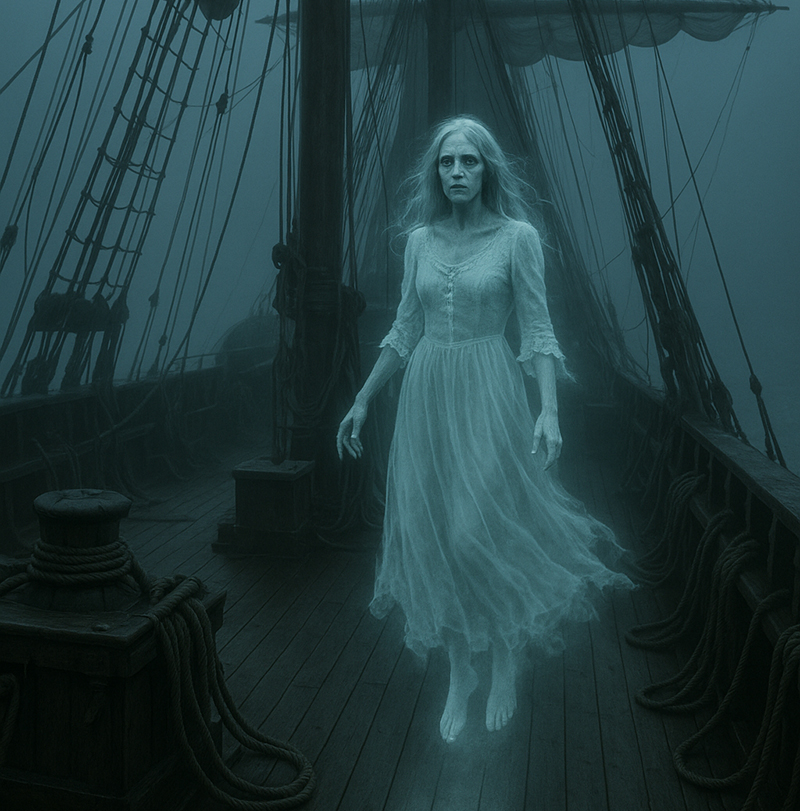There’s something about the ocean when the pitch-black of darkness ushers in the mysteries of the night. It’s enough to test the imagination and mettle of even the boldest seafarers. And sometimes, when the wind drops ever so suddenly and the stars seem close enough to touch, yarns of supernatural ruin rise up like fog from the deepest depths of the ocean’s floor.
While the Ocean’s have birthed more ghost stories than there are stars reflected upon them, few have truly unmoored the hearts of sailors like the tales of the “Lady of the Sea” and “The Cursed Whaler Young Phoenix.” And what better time than Halloween, when the veil between water and sky grows thin, to imbibe a Guinness or two (or three) and take poetic license to meld these spectral stories into one unsettling tall tale?
The Lady of the Sea
She was known by many names: the White Widow, the Pale Mariner’s Bride, the Phantom Witch of the Night Watch. But most called her the “Lady of the Sea.” Her legend dates back to the early 18th century, whispered in dockside taverns from Lisbon to Cape Cod.
The story goes that she appeared on moonless nights — a woman in white, luminescent and silent, drifting across the decks of ships. Her gown, soaked and tattered, rippled without wind. Her eyes, wide and vacant, glimmered with seawater and moonlight.
Those who claimed to have seen her said she glided rather than walked, her bare feet never quite touching the boards. She didn’t speak; she didn’t have to. Her appearance alone was enough to stop hardened sailors in their tasks, because she was always a herald of death. Sometimes the waves rose in fury within hours. Other times, a mutiny broke out, or a man vanished overboard. When recovered, his face was pale and empty, as though the ocean had drunk from his soul.
One 19th-century logbook from a British merchant vessel recorded that the entire night watch saw the “white Lady crossing abaft the mainmast” just before the ship’s rigging failed and three men were lost.
Another account, from an American brig sailing off Nova Scotia, described “a glowing woman on the forecastle, her hair like sea foam, her face full of sorrow.” The next night, their captain fell mysteriously ill and died before dawn, his face locked in an expression of horror.
The crew never heard her speak aloud, yet some sailors swore her presence plagued their thoughts with a voice whispering the same, almost indistinguishable words again and again: “Your captain will never return to port.”
Was the Lady the ghost of a sailor’s widow, searching for her lost love? Or perhaps the ocean herself, taking human form to warn, or punish, those who dared to cross her? Whatever she was, her legend endured because she appeared to the living only when fate had already chosen who would join her beneath the waves.
Even the most skeptical captains, the ones who laughed off omens and curses, grew uneasy when the crew began to talk of the “Lady.” At sea, a rumor can capsize hearts faster than a gale can snap a mast.
The Cursed Whaler Young Phoenix
Of course, some ships didn’t need an omen to seal their fate; they were already damned. So goes the tale of the Young Phoenix, a whaler out of New Bedford that set sail in 1847 and returned only as a ghost.
Like most whaling ships, Young Phoenix was a hunting leviathan that could crush a smaller vessel like driftwood. Known for her daring voyages, the ship left port with a crew of thirty. Whaling was brutal work, with months or even years from home, but the payoff was enormous. Whale oil lit cities, lubricated machinery, and made fortunes. The men aboard were proud, tough, and superstitious in equal measure.
Their last sighting came in the Azores, where they mocked a priest’s offer of blessing. One sailor reportedly jeered, “The sea’s our church, and the whales are our choir.” The next morning, Young Phoenix slipped over the horizon and vanished.
Friends mourned. Wives remarried. The ship was assumed lost to storms or ice. That is, until five years later, in 1852, when the whaler Perseverance found a derelict drifting near Greenland. Its timbers were bleached, sails in shreds, but the name “Young Phoenix” could still be read on the stern.
The boarding party found the ship eerily intact, with no signs of violence. No blood. No bodies.
What unsettled them most was the absence of odor. After five years adrift, the long lost vessel should have reeked of rot, but she smelled clean, too clean, like fresh rain. Though the rigging creaked in the wind, not a rope snapped or splinter groaned; it was as if the ship itself were still alive, or refused to die.
The logbook only provided another riddle. Its final entry ended abruptly, as if the writer had been swept away mid-sentence:
“The Lady walks again tonight—”
Perseverance lashed Young Phoenix to tow her home, but that night, under a sky too clear for storms, one struck anyway. Lightning forked across calm waters. The towline snapped. Young Phoenix vanished again into the blackness.
Years later, ships reported seeing her silhouette gliding through fog near Nantucket, her sails full though the wind was dead.
In 1868, a whaling captain claimed a phantom ship “passed through” his own vessel “like a mist,” leaving the deck slick with seawater that smelled faintly of iron.
Among whalers, one belief rumor took hold: Young Phoenix and her crew had been claimed by Davy Jones’ Locker — and the same ancient forces that controlled waves and storms, long before man dared challenge them. To this day, sailors say if you spot a derelict with no crew and pristine decks, best not to approach. It might be that Young Phoenix still sails under ghostly command, her men bound forever to the hunt.
When the Deep Calls Twice
Now, here’s where the stories converge. After all, superstition loves company. The first written accounts of “The Lady of the Sea” spread only a few years before Young Phoenix first vanished, and that unfinished log entry, “The Lady walks again tonight,” feels more than coincidental.
Maybe the Lady boarded Young Phoenix, drifting silently across the deck as the crew froze in terror. Maybe they mocked her and went back to their hunt. Maybe the next day the ocean rose up and took them all. And maybe, just maybe, the ship that returned wasn’t a ship at all.
It’s the kind of story old mariners tell when the rum flows freely and the fog thickens, the kind that ends with a long silence punctuated by wary looks toward the dusky horizon. Because every sailor, no matter how rational, has seen something out there that defies reason, like a seductive whisper calling their name from beyond the bulwark.
The Sea Remembers
It never, ever forgets. It keeps its dead close and its secrets closer, locked away beneath leagues of cold, briny silence. Every so often though, a mystery escapes from its captive depths and rises to the surface. Maybe it’s an unsettling lull between waves that feels too still, too aware. Perhaps it’s a murky apparition, barely discernable through the ocean mist. Or maybe, just maybe, it’s every seafaring soul’s nightmare — a crewless ghost ship, adrift upon the horizon.
As Halloween rolls around, take note if the coastal winds pick up. Listen closely to the surf. The waves have a voice older than any language, one that’s inspired thousands of stories, both tall and true.
And if you see a ship at anchor near dusk, with an empty deck, no lights, no sound but the creak of its lines, steer away. Because if a woman in white happens to appear on the bow, watching you through the mist — she isn’t waiting for rescue.
She’s looking for new souls to join her crew.





